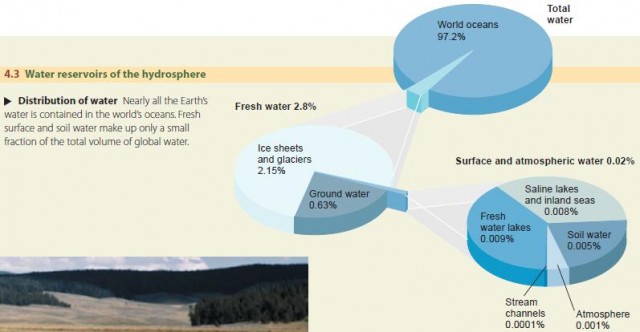Water in the Environment
In this chapter, we focus on water in the air, both as vapor and as liquid and solid water. Precipitation is the fall of liquid or solid water from the atmosphere that reaches the Earth's land or ocean surface. It forms when moist air is cooled, causing water vapor to form liquid droplets or solid ice particles. If cooling is sufficient, liquid and solid water particles will grow to a size too large to be held aloft by the motion of the atmosphere. They can then fall to the Earth. Before we begin our study of atmospheric moisture and precipitation, however, we will briefly review the three states of water and the conversion of one state to another.
THREE STATES OF WATER
Water can exist in three states—as a solid (ice), as a liquid (water), or as an invisible gas (water vapor), as shown in Figure 4.2. If we want to change the state of water from solid to liquid, liquid to gas, or solid to gas, we must put in heat energy. This energy, which is drawn in from the surroundings and stored within the water molecules, is called latent heat. When the change goes the other way, from liquid to solid, gas to liquid, or gas to solid, this latent heat is released to the surroundings. Sublimation is the direct transition from solid to vapor. Perhaps you have noticed that old ice cubes left in the freezer shrink away from the sides of the ice cube tray and get smaller.

They shrink through sublimation—never melting, but losing mass directly as vapor. In this book, we use the term deposition to describe the reverse process, when water vapor crystallizes directly as ice. Frost forming on a cold winter night is a common example of deposition.
THE HYDROSPHERE
The realm of water in all its forms, and the flows of water among ocean, land, and atmosphere, are known as the hydrosphere, shown in Figure 4.3. About 97.2 percent of the hydrosphere consists of ocean salt water. The remaining 2.8 percent is fresh water. The next largest reservoir is fresh water stored as ice in the world's ice sheets and mountain glaciers, which accounts for 2.15 percent of total global water.
Fresh liquid water is found above and below the Earth's land surfaces. Subsurface water lurks in openings in soil and rock. Most of it is held in deep storage as ground water, where plant roots cannot reach. Ground water makes up 0.63 percent of the hydrosphere. The small remaining proportion of the Earth's water includes the water available for plants, animals, and human use. Plant roots can access soil water. Surface water is held in streams, lakes, marshes, and swamps.

Most of this surface water is about evenly divided between freshwater lakes and saline (salty) lakes. An extremely small proportion makes up the streams and rivers that flow toward the sea or inland lakes. Only a very small quantity of water is held as vapor and cloud water droplets in the atmosphere—just 0.001 percent of the hydrosphere. However, this small reservoir of water is enormously important. Through precipitation, it supplies water and ice to replenish all freshwater stocks on land. In addition, this water, and its conversion from one form to another in the atmosphere, is an essential part of weather events across the globe. Finally, the flow of water vapor from warm tropical oceans to cooler regions provides a global flow of heat from low to high latitudes.
THE HYDROLOGIC CYCLE
The hydrologic cycle, or water cycle, moves water from land and ocean to the atmosphere. Water from the oceans and from land surfaces evaporates, changing state from liquid to vapor and entering the atmosphere. Total evaporation is about six times greater over oceans than land because oceans cover most of the planet and because land surfaces are not always wet enough to yield much water. Water vapor in the atmosphere can condense or deposit to form clouds and precipitation, which falls to Earth as rain, snow, or hail. There is nearly four times as much precipitation over oceans than precipitation over land.
When it hits land, precipitation has three fates. First, it can evaporate and return to the atmosphere as water vapor. Second, it can sink into the soil and then into the surface rock layers below. As we will see in later chapters, this subsurface water emerges from below to feed rivers, lakes, and even ocean margins. Third, precipitation can run off the land, concentrating in streams and rivers that eventually carry it to the ocean or to lakes. This flow is known as runoff.
Because our planet contains only a fixed amount of water, a global balance must be maintained among flows of water to and from the lands, oceans, and atmosphere.
For the ocean, evaporation leaving the ocean is approximately 420 km3/yr (101 mi3/yr), while the amount entering the ocean via precipitation is 380 km3/yr (91 mi3/yr). There is an imbalance between the amount of water lost to evaporation and the amount gained through precipitation. This imbalance is made up by the 40 km3/yr (10 mi3/yr) that flows from the land back to the ocean.
Similarly, for the land surfaces of the world, there is a balance. Of the 110 km3/yr (27 mi3/yr) of water that falls on the land surfaces, 70 km3/yr (17 mi3/yr) is reevaporated back into the atmosphere. The remaining 40 km3/yr (10 mi3/yr) stays in the form of liquid water and eventually flows back into the ocean. Of all these pathways, we will be most concerned with one aspect of the hydrologic cycle—the flow of water from the atmosphere to the surface in the form of precipitation. To understand this process, we first need to examine how water vapor in the atmosphere is converted into clouds and subsequently into precipitation.